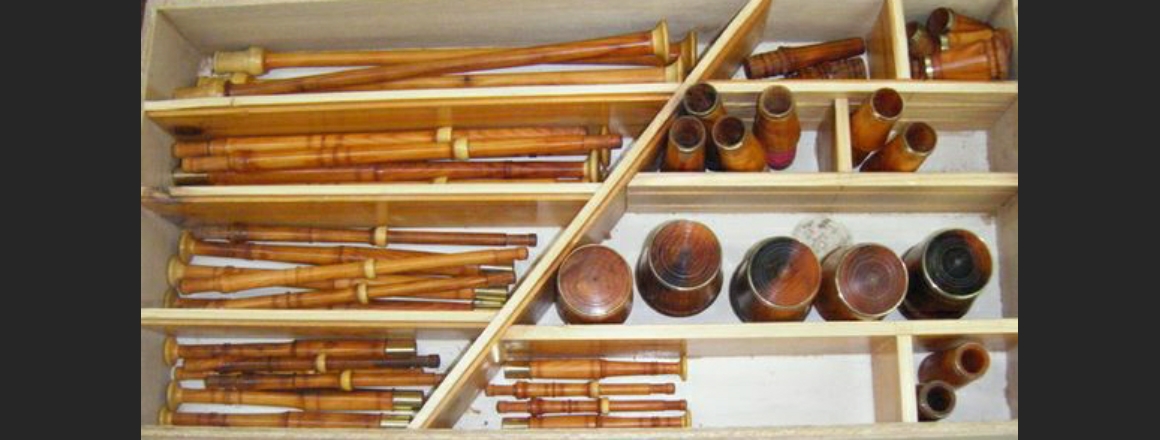An article by Pete Stewart and me for Common Stock, the journal of The Lowland and Border Pipers' Society in 2005, as an attempt to clarify the terminology of fingering systems
-

Talking about pipe-making and pipe-playing
Pipe Making
- HIGHLAND PIPEMAKING IN INDIA
- Some observations about the relationship of the musician to the instrument maker.
- TOOLS OF THE TRADE - LOOMING PINS AND CORDWANGLER
- HOW LONG DOES IT TAKE TO MAKE A BAGPIPE?
- VACUUM AND PRESSURE OIL TREATMENT OF WOOD
- INTO THE FLAMES.
- Closed and covered fingering on smallpipes
- GOODACRE'S RAZOR
- Bagpipe Fingering Systems
- Bagpipe Bags- Form and Function
- Working As a Bagpipe Maker
- Some Of Me Pipes.... Some of Me Woods
- Pipes from the Village. Piping in the Village
I wrote this article in January 2020 for FoMRHI Quarterly - The Fellowship of Makers and Researchers of Historical Instruments.
The full title is :
The tribulations of designing a bagpipe chanter for the specific requirements of an individual customer lead me to make some observations about the relationship of the musician and the instrument maker.
Preamble
The Secretary asked what we are doing in our workshops, which has prompted me to share the saga of my search to design a stable bagpipe chanter in A. But while writing this I began to ponder on the interplay between the demands of musicians and the abilities of instrument makers throughout the ages.
Over the years I have honoured several of my tools by giving them specific names. In a previous edition of Chanter I described Goodacre’s Razor, an invaluable tuning tool, which I named in honour of Mr Occam, of Ockham (a small village in Surrey), who may- or may- not have actually even existed.
In a misguided fit of enthusiasm in 1978 my brother John bought new a set of Pakistani-made Highland bagpipes from Ray Mann, a music shop near Covent Garden, London, that specialised in unusual musical instruments. The bag was greasy, gave off a distinctive, but not entirely offensive stench and leaked like a sieve, the valve didn't operate properly and the reeds were atrocious. Neither of us had any previous experience with bagpipes. We tried putting corks in the drones and took it in turns to squeeze some sort of noise out of the wretched thing. This usually ended in one of us hyperventilating whilst the other roared with laughter.
Any instrument maker is liable to be asked this question and I always find it a tricky one to answer. Where should I start? My pipes are made of wood and I cut down much of it myself which then involves leaving it to season for at least four years. Should my answer disregard this time? In actual fact some of the trees I use were planted by Dad in the 1940’s which was before I was born. It would be deliberately confusing to include the time each tree takes to grow.
I wrote this in Feb 2016 for FoHMRHI; The Fellowship of Makers and Researchers of Historic Instruments.
I have been enthralled by all the recent and exhaustive Comms by Jan Bouterse on instrument measuring and making . I wonder if he has plans to turn them into book form? If, by some magic, I had been able to read it 35 years previously, my life as an instrument maker might have been less fraught with difficulties, challenges and mistakes!
In Comm 2044 he writes that he will give us his experiences of impregnating and sealing wood with oil in a later article. Here I offer my own practical account of the treatment that I have been using for over 20 years for all the turned wooden parts on the various types of bagpipes that I make.
I wrote this article for Chanter, the Journal of the Bagpipe Society, in April 2015
A CUT BELOW THE OTHERS.
Julian Goodacre shares the secret of his favourite tuning tool
In June this year I will be 66 years old. I made my first bagpipe 33 years ago, during which time I have completed over 820 sets and have made over 1432 chanters, if my records can be relied on.
Closed fingering, covered fingering, open fingering, half closed fingering, half open fingering, cross fingering, happy fingering, forked fingering, false fingering, pinched fingering, sticky fingering…
What is fingering?
- You are here:
- Welcome |
- About Me |
- My Writings |
- Pipe Making
Bagpiping Links
© 2024 Stable Base Design
